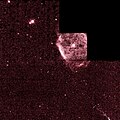NGC 40
| Emission nebula | |
|---|---|
| Planetary nebula | |
 | |
| Observation data: J2000 epoch | |
| Right ascension | 00h 13m 01.015s[1] |
| Declination | +72° 31′ 19.085″[1] |
| Distance | ~3,500 ly (~1.0 kpc)[2] ly |
| Apparent magnitude (V) | 10.7,[1] 11.6[2] |
| Apparent dimensions (V) | 38″ × 35″[2] |
| Constellation | Cepheus |
| Designations | Bow-Tie Nebula, Caldwell 2 |
NGC 40 (also known as the Bow-Tie Nebula and Caldwell 2) is a planetary nebula discovered by William Herschel on November 25, 1788, and is composed of hot gas around a dying star. The star has ejected its outer layer which has left behind a smaller, hot star with a temperature on the surface of about 50,000 degrees Celsius.[3] Radiation from the star causes the shed outer layer to heat to about 10,000 degrees Celsius,[3] and is about one light-year across.[3] About 30,000 years from now, scientists theorize that NGC 40 will fade away, leaving only a white dwarf star approximately the size of Earth.[3]
Currently the central star of NGC 40 has a spectral type of [WC8], indicating a spectrum similar to that of a carbon-rich Wolf–Rayet star.[4]
Gallery[]

HST
References[]
- ^ a b c "NGC 40". SIMBAD. Centre de données astronomiques de Strasbourg. Retrieved 2006-12-22.
- ^ a b c O'Meara, Stephen James (2002). Deep Sky Companions: The Caldwell Objects. Sky Publishing Corporation. pp. 22–23. ISBN 978-0-933346-97-0.
- ^ a b c d "Chandra X-Ray Observatory". Retrieved 2007-06-05.
- ^ González-Santamaría, I.; Manteiga, M.; Manchado, A.; Ulla, A.; Dafonte, C.; López Varela, P. (2021). "Planetary nebulae in Gaia EDR3: Central star identification, properties, and binarity". Astronomy & Astrophysics. 656: A51. arXiv:2109.12114. Bibcode:2021A&A...656A..51G. doi:10.1051/0004-6361/202141916. S2CID 237940344.
External links[]
 Media related to NGC 40 at Wikimedia Commons
Media related to NGC 40 at Wikimedia Commons- NGC 40 on WikiSky: DSS2, SDSS, GALEX, IRAS, Hydrogen α, X-Ray, Astrophoto, Sky Map, Articles and images
- Toalá, J. A.; Ramos-Larios, G.; Guerrero, M. A.; Todt, H. (2019). "Hidden IR structures in NGC 40: Signpost of an ancient born-again event". Monthly Notices of the Royal Astronomical Society. 485 (3): 3360–3369. arXiv:1902.11219. doi:10.1093/mnras/stz624.
- Kameswara Rao, N.; Sutaria, F.; Murthy, J.; Krishna, S.; Mohan, R.; Ray, A. (2018). "Planetary nebulae with UVIT: Far ultra-violet halo around the Bow Tie nebula (NGC 40)". Astronomy & Astrophysics. 609: L1. arXiv:1711.07698. Bibcode:2018A&A...609L...1K. doi:10.1051/0004-6361/201732188. S2CID 55637703.
Coordinates: ![]() 00h 13m 01s, +72° 31′ 19″
00h 13m 01s, +72° 31′ 19″
- Planetary nebulae
- Cepheus (constellation)
- NGC objects
- Caldwell objects
- Astronomical objects discovered in 1788
- Discoveries by William Herschel
- Nebula stubs
